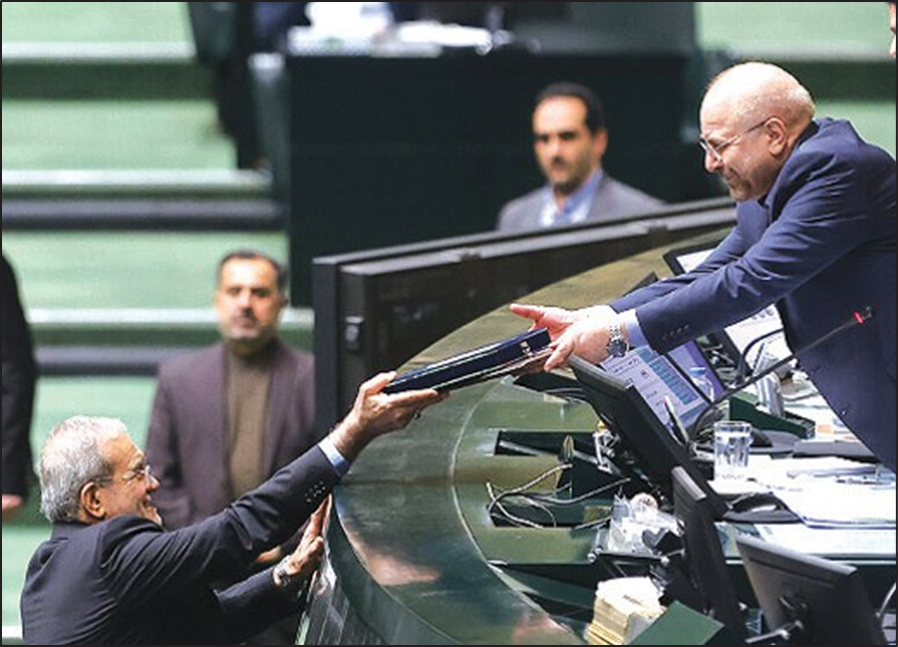January 25, 2019
by Warren L. Nelson

The Islamic Republic has lofted its first satellite in four years into space, but the satellite failed to go into orbit and instead crashed into the Indian Ocean.
This was the first time the regime has announced a satellite launching that failed. It has normally been loath to do this and admit failure.
It was also the first announced effort to use the Simorgh rocket to put a satellite into orbit. The Simorgh is much bigger than the Safir rocket that Iran has used with all its previous satellite launchings. But the Simorgh is still small compared to other satellite launchers used around the world.
Telecommunications Minister Mohammad-Javad Azari-Jahromi announced the failure January 15, hours after the launch. He said the first two stages operated perfectly, but the third or top stage failed to achieve enough speed to put the satellite in orbit. He didn’t make clear if the third stage rocket failed to ignite at all or did not fire for as long as intended.
The United States and France condemned the launch. The US said the Simorgh’s technology is “virtually identical and interchangeable with those used in ballistic missiles.” Analysts generally call that an exaggeration, though there is much technology overlap. (See accompanying article on US Secretary of State Mike Pompeo’s comments on page eight.)
Russian Deputy Foreign Minister Sergey Ryabkov said Iran did nothing wrong and there was no basis for criticizing it.
The day before the launch, President Rohani said Iran would loft two satellites in a matter of days. The day after the failure, he said a second satellite would be orbited in “a few months.” He said, “We are on the right track. The remaining problems are minor, will be resolved in a few months and we will soon be ready for a new launch.”
As the accompanying table shows, Iran is constantly announcing satellite launches that simply do not materialize.
The Safir rocket that has been used until now for satellite launches weighs in at 26,000 kilograms. The Simorgh is more than triple the size at 87,000 kilograms. But that still is not much in the world of space launchers. The Russia Soyuz-2 workhorse satellite launcher comes to 312,000 kilos, the European Ariane-5 at 860,000 and the Falcon Heavy, built by American entrepreneur Elon Musk, weighs in at 1,420,738 kilos and was used last year for the first time and put an automobile Musk’s company builds into outer space.
The Islamic Republic has been working on the Simorgh for a decade and clearly has had serious problems developing it. It was unveiled in 2010 with talk of a test launch soon. But its first launch, a sub-orbital test, did not come until April 2016. A year later, in July 2017, a full test was attempted, but the second stage failed. It has taken another 18 months until Iran felt confident enough to try another Simorgh launch this month.
But the bigger problem Iran has had is getting a satellite into a circular orbit. It still has not learned to do that. The orbits are elliptical and the satellites soon fall to earth. Iran’s first satellite, Omid, was launched in February 2009 and only stayed up 80 days. Iran has since placed three more satellites into orbit, but none have survived even 80 days. They have lasted 21, 60 and 24 days. Despite 10 years of effort, Iran’s space agency still isn’t getting the basics right.
Iran’s very first satellite, Sina, was designed, built and lofted by Russia on September 27, 2005. It is still circling the earth. But Iran never even talks about it.
The latest satellite Iran tried to orbit this month is the Payam, built at Amir Kabir University of Technology. At 110 kilos, it was more than double the size of any previous Iranian satellite. At that size, the Safir, with a maximum payload of about 100 kilos, could not carry it. The Simorgh is understood to be able to carry 350 kilos.
Iran only unveiled the Payam last fall and said the plan was to launch it before Now Ruz 2019, putting it at the front of the queue and ignoring a dozen other satellites Iran has talked about in the past. The next satellite Rohani said will be launched is the Doosti, which Iran has previously announced would be lofted before Now Ruz 2017, 2018 and 2019.
A few weeks ago, Iranian officials said one of the new satellites to be orbited would carry a camera capable of distinguishing objects on the ground as small as 40 meters (131 feet) across.
What they didn’t say is that commercial satellites, whose products Iran could buy, can take much better photos than that. The GeoEye-1 satellite, in orbit since 2008, is able to collect images of objects as small as 41 centimeters (16 inches) across. In other words, the GeoEye photos are 98 times better than what Iran claims it will get from its own satellite.
Some critics complain that the space program is just a prestige endeavor of the type that the revolution condemned 40 years ago, denouncing the Shah for wasting money on such things as a nuclear program and a Tehran subway and a superhighway to the Caspian, which revolutionaries said were just intended to make the Shah look good. All are now “revolutionary” projects.
But the United States is concerned that Iran is using the space program chiefly to test missiles able to hit the United States. Satellite launchers and intercontinental ballistic missiles (ICBMs) share many characteristics.
In separate announcements the first week of January, Telecommunications Minister Mohammad-Javad Azari-Jahromi and Space Agency chief Morteza Barari spoke of four satellites being on the verge of launch—Payam, Zafar, Doosti and Nahid. On January 10, President Rohani said Iran would launch two satellites shortly, but did not name them.
However, Iran’s record of implementing its announced launch schedules has been astoundingly poor. (See accompanying table.) Over the last six years, Iran has announced launch plans for 14 different satellites. Only two of them have been launched. (It is possible that others were launched and failed to go in to orbit. Iran does not televise launches live. Until this month, it only announced them when they succeeded. So, it is possible some satellite launches have crashed.)
The only one of those 14 satellites to go into orbit so far was Fajr (Dawn). In January 2013, the regime said Fajr would be launched by February 8, 2013. In February 2013, it was to be launched by Now Ruz 2014. In May 2014, it was to be launched by Now Ruz 2015. And, indeed, it was launched February 2, 2015. But it fell out of orbit and burned up after just 24 days. Iran has still not announced that fate. In fact, published news accounts still describe the Fajr as if it remains in orbit.
The latest launch was not on the usual schedule. Iran likes to loft satellites in the first week of February to correspond with the anniversary of the 1979 revolution. This year, being the 40th anniversary, a launch was anticipated for then. And commercial American satellites had been watching the Semnan rocket launch center and reported weeks ago that a rocket was being prepared there for launch. The fact that Iran knew the Americans were watching may be why the telecommunications minister announced the failure, rather than allow the American media to reveal it.



















